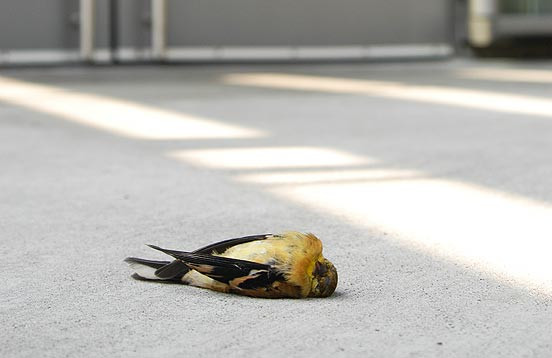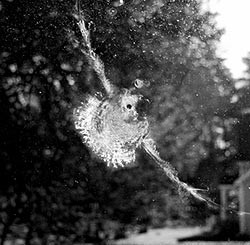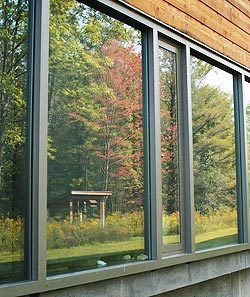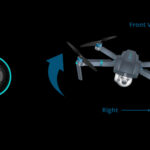Window collisions pose a significant threat to bird populations. Astonishingly, up to one billion birds in the U.S. alone perish each year due to window strikes, as highlighted in a comprehensive 2014 study. These glass panes, reflecting inviting scenes of foliage and sky, become invisible barriers for birds in flight. However, the good news is that you can take meaningful steps to significantly decrease this danger around your home.
 American goldfinch, a bird species vulnerable to window strikes, lying deceased on the ground, emphasizing the impact of window collisions on birdlife
American goldfinch, a bird species vulnerable to window strikes, lying deceased on the ground, emphasizing the impact of window collisions on birdlife
According to Christine Sheppard, the program director for Bird Collisions at the American Bird Conservancy (ABC), simple solutions can make a world of difference. The ABC, along with organizations like the Fatal Light Awareness Program (FLAP), provides extensive resources on their websites dedicated to preventing these tragic incidents. Understanding why these collisions occur and implementing preventative measures is crucial for bird conservation.
Understanding Why Birds Fly Into Windows
Bird window collisions are broadly categorized into daytime and nighttime incidents, each with distinct causes. During the day, the primary culprit is reflection. Birds perceive the reflections of surrounding trees, vegetation, or even the sky in glass windows as continuous habitat, not realizing they are solid barriers. They also may attempt to fly through windows to reach indoor plants or vegetation they see through the clear glass.
 Window imprint of a dove, showcasing the visible outline left after a bird collision, illustrating the force and impact of such incidents
Window imprint of a dove, showcasing the visible outline left after a bird collision, illustrating the force and impact of such incidents
At night, especially for nocturnal migrating birds like songbirds, artificial lights become a major hazard. Migrating birds are often disoriented by bright lights in urban areas, particularly during foggy or low-ceiling conditions. These lights can divert them from their natural migratory paths, causing them to mill around in brightly lit areas, increasing the risk of collisions with buildings and windows. Furthermore, birds attracted to urban lights overnight may then face daytime window reflection hazards the following day. Projects like BirdCast and FLAP are actively working to address the problem of light pollution and its impact on migratory birds.
Another less common reason for window strikes is territorial behavior. Birds, particularly during the spring breeding season, may see their own reflection in a window and perceive it as a rival. This can lead to aggressive attacks on the reflection, though this type of collision is less likely to be fatal compared to those caused by misinterpreting reflections of habitat.
Effective Ways to Make Your Windows Bird-Safe
To effectively prevent bird window strikes, it’s essential to first identify which windows around your home pose the greatest risk. Large picture windows, corner windows, and windows located near bird feeders are often the most problematic. Step outside your home and view your windows from a bird’s perspective. If you see reflections of trees, bushes, or sky in the glass, those windows are potential hazards.
 Window reflecting a natural landscape, highlighting how such reflections deceive birds into perceiving open flight paths, leading to collisions
Window reflecting a natural landscape, highlighting how such reflections deceive birds into perceiving open flight paths, leading to collisions
Contrary to older advice, the distance of bird feeders from windows is less critical than making the windows themselves bird-safe. If you have windows near feeders, prioritizing window treatments is key. Here are several effective treatments for existing windows:
Solutions for Existing Windows
The principle behind most window treatments is to break up the reflection and make the glass visible to birds. For smaller birds, markings should ideally be spaced no more than 2 inches apart. For larger, more visible deterrents like Acopian BirdSavers, spacing can be up to 4 inches. Always apply treatments to the exterior surface of the window.
-
Tempera Paint or Soap: An affordable and straightforward method is to use tempera paint or soap to create patterns on the outside of your windows. You can use a simple 2×2 inch grid pattern or create more decorative designs. These markings are temporary but easily reapplied.
-
Window Decals and Stickers: Applying decals, stickers, sun catchers, mylar strips, or even masking tape to the exterior of windows can be effective if spaced closely together. It’s crucial to understand that hawk silhouettes alone are not effective bird deterrents. A few widely spaced stickers on a large window will not prevent collisions; the majority of the glass surface needs to be covered with narrow gaps between markings.
-
Dot Patterns and Window Tape: Specialized window tapes with pre-spaced dot patterns offer a more durable and easily applied solution for creating the necessary visual disruption. Products from companies like Feather Friendly are designed specifically for bird collision prevention and provide the correct spacing for effective deterrence.
-
Acopian BirdSavers (Zen Curtains): These consist of closely spaced cords hanging vertically down the window. They function similarly to tapes or decals but are often easier to install and can be aesthetically pleasing. Highly effective, Acopian BirdSavers are used at the Cornell Lab of Ornithology headquarters to protect birds. You can purchase pre-made BirdSavers or create your own DIY versions.
-
Window Screens: Installing mosquito screens over your windows is a highly effective solution, provided they are mounted on the outside and cover the entire window surface. The screen mesh makes the window surface visible and prevents reflections.
-
Netting: Covering windows with netting on the outside, positioned at least 3 inches away from the glass and taut enough to deflect birds, provides a physical barrier. Small-mesh netting (around 5/8″ or 1.6 cm) is ideal to prevent entanglement while ensuring birds bounce off safely. Netting can be mounted on frames for easy installation and removal.
-
One-Way Transparent Film: Films like Collidescape are designed to be transparent from the inside, allowing homeowners to see out, but appear opaque to birds from the outside. These films can also reduce sunlight penetration, potentially lowering cooling costs in warmer months.
Planning for New Homes and Remodeling
If you are building a new home or renovating, you have the opportunity to incorporate bird-friendly design elements from the outset:
-
External Shutters: Installing and using external shutters, especially when rooms are unoccupied or when natural light is not needed, significantly reduces window reflections and can also provide energy savings.
-
External Shades and Awnings: Sun shades or awnings mounted externally block sunlight reflections, making windows less hazardous to birds. Remote-controlled options offer convenience and flexibility.
-
Window Design: Consider windows with integrated external screens that cover the entire glass surface. This provides continuous bird protection.
-
Interior Vertical Blinds: Using interior vertical blinds and keeping the slats partially closed can help break up reflections and reduce bird collisions.
-
Minimize Visual Pathways: Avoid creating direct visual paths through your house to outdoor greenery or sky. For example, if a picture window directly faces another bright window on the opposite wall, it can create the illusion of a continuous open flight path. Closing interior doors or using shades to block these visual paths can be helpful.
Lights Out Initiatives
Participating in “Lights Out” initiatives is crucial, particularly in urban areas. Cities like New York, Dallas, Houston, and Philadelphia are implementing Lights Out programs to reduce nighttime light pollution. Turning off non-essential lights in buildings, especially during bird migration seasons, and using downward-facing outdoor lighting significantly reduces the disorientation and danger posed to nocturnal migrating birds. However, even with city-wide initiatives, individual homeowners should still implement window safety measures.
How to Help a Bird That Has Hit a Window
Despite preventative measures, window collisions can still occur. If you find a bird that has struck a window, immediate action can improve its chances of survival. Even if a bird appears to fly away after a collision, it may have internal injuries.
-
Capture and Contain: Approach the bird gently from behind and use both hands to carefully scoop it up. Small birds are fragile, so hold it gently but securely, without squeezing.
-
Prepare a Container: Place the bird in a safe container, such as an unwaxed paper bag or a small cardboard box lined with soft tissue or paper towel. Ensure the container is closed and place it in a dark, quiet, warm, and safe location away from pets and children.
-
Do Not Feed or Water: Avoid handling, feeding, or giving water to the bird. Wild birds are easily stressed, and human interaction can be harmful.
-
Contact a Wildlife Rehabilitator: Locate a licensed wildlife rehabilitator in your area using online directories. Contact them for guidance and instructions. They may be able to provide specific care or arrange for transport.
-
Release Instructions: If the rehabilitator advises you to release the bird, take it to a safe, wooded area away from buildings. Before releasing, observe its flight ability. Point the container towards vegetation and gently open it. If the bird doesn’t fly strongly, recapture it and contact the rehabilitator for further assistance.
By understanding the causes of bird window collisions and implementing these preventative measures, you can make your home and surroundings safer for birds and contribute to bird conservation efforts. Every window made bird-safe is a step towards protecting these vital and beautiful creatures.

